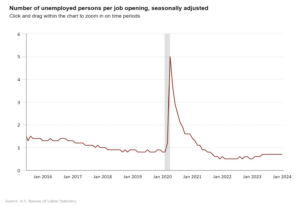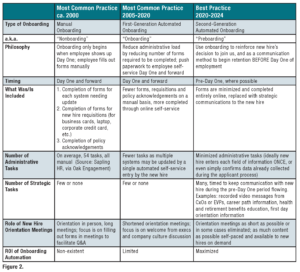New hire “ghosting” – the situation where a new hire accepts their offer from an employer but fails to show up on Day One of employment – is the subject of several myths among employers. These include the following: (a.) It is rare, (b.) it is limited to specific industries like hospitality or retail, and (c.) it impacts only the lowest-paid positions.
However, an article appearing in Forbes online in October 2023 by Senior Contributor Jack Kelly (“Why Poor Onboarding Experiences Can Lead to New Hires Not Showing Up on Their First Day”)1 helps us to explode these myths and face the facts:
- In a survey by The Harris Poll, nearly 70 percent of employers reported ghosting rates of up to 25 percent – new hires not showing up on Day One after accepting a new position.
- A new hire’s willingness to “ghost” their new employer on Day One appears to be a function of that new hire’s age, with Gen Z’ers the most likely – 87% of surveyed Gen Z’ers have reported ghosting at least one employer. 2
- Additional demographics of ghosting discovered by a Spiceworks survey include: 3
- Women are less likely to ghost an employer than men.
- Senior-level workers (managers and directors) were more likely to ghost than individual contributors.
- Vice presidents and C-Suite executives were more likely to ghost than other employees.
- First-time job seekers were more likely to ghost than others.
The Impact of Ghosting in a Clearly ‘On-Fire’ Employment Economy
What explains this pre-Day One job abandonment trend reaching previously unseen levels in 2023 and 2024? The jobs economy in the United States is riding a two-year high – in terms of jobs created, unemployment rate, and the ratio of open jobs to workers available to consider and take them. This trend is inuring to the benefit of many workers, consumers, and investors – but it is axiomatic to economic realities that a significant trend with many “winners” must also have one or more “loser” constituencies. In this case, arguably, the major groups that find the burning hot jobs economy problematic are recruiting professionals and HR managers.
The power dynamic between recruiters and candidates has been reversed dramatically in the current economy, particularly since the height of the pandemic in early 2020. When the ratio of open jobs to unemployed workers (generally) changes from 5.0 in April 2020 to 0.7 in January 2024 (barely higher than the decades-low record of 0.5 in December of 2022; See Figure 1), that implies an empirical ten-fold increase over that period, in “candidate power,” and an attendant decrease in “recruiter power.” The reason is clear: candidates have more jobs to choose from, leading to more interviews and more confirmed job offers. Therefore, they are empowered, in their minds, to no-show with little to no negative consequence at a higher rate.

Figure 1.
The Mechanics of Ghosting
In such an economy, the mechanics of ghosting become clear. The competition for the most challenging positions to fill can become fierce. Most industries have such positions. For example, in healthcare, it is usually more difficult to fill patient-facing clinical positions than other openings, more challenging still to fill nursing jobs, tougher still to fill RNs, more challenging still to fill critical care nurses, and most demanding, perhaps, to fill RN/BSN nurse managers. Such cutthroat competition can easily result in wage and benefits inflation and even induce virtual “bidding wars” involving base rates, overtime, schedule promises, and perks. This is equivalent to “throwing money at the problem” and can be very expensive for employers. Is there a better way?
Examining the tail end of the recruiting process “(decision è offer letter è acceptance è job start),” recruiters and hiring managers usually know, intuitively, which are the most sought-after candidates – the top 10 to 15 percent of all candidates based on perceptions of those candidates’ experience, education, performance, and potential. The increase in ghosting has taught us that merely offering these “best and the brightest” a competitive salary and receiving back a signed offer letter doesn’t guarantee a Day One appearance by that new hire.
Instead, it begins a period of uncertainty for the employer. The new hire may be giving a two-week notice to their current employer. They may take some time off. They may plan to gap their two employment stints with gig work.
Regardless of the specific situation, unless the new hire starts the day after accepting the offer, we know that one group of people is very busy during this gap – the new employer’s competitors who lost out on this best-and-brightest worker and may come back with sweetened offers. Meanwhile, the new hire may be going through some degree of “buyer’s remorse.” Just as with other major financial decisions in a person’s life (buying a new car, buying a new house), it is natural to have “second thoughts” about the decision.
Indeed, those second thoughts may be stronger in the case of a new job, likely accompanied by an unknown new employer, unknown new supervisor, uncertain job responsibilities, and no chance to “take a test drive” as with an automobile.
The result? Uncertainty for the new employer and angst for the new hire. Employment experts generally agree that one key solution for this problem is better, more consistent communication between the two parties throughout that delayed start period – whether a few days or two weeks – which translates to better, more modern onboarding practices.
The Current Onboarding Landscape
A survey of current onboarding practices across organizations and industries reveals high variability among employers but even higher dissatisfaction among job starters. In a December 2023 blog post, explodingtopics.com provided some current and eye-opening statistics about onboarding practices in the USA: 4
- 36 percent of employers don’t have a structured onboarding process,
- Organizations with solid employee onboarding can increase retention by 82 percent, according to the Brandon Hall Group,
- Just 12 percent of US employees say their organization has a good onboarding process, according to Gallup,
- 81 percent of new hires say they feel overwhelmed with information during the onboarding process, and
- The average onboarding cost is $1,830 per new hire (this will become important in the ROI review below,) but 35 percent of organizations spend $0 on onboarding new hires.
At the same time, survey after survey shows that new hires either have quit or plan to quit because of poor onboarding experiences at rates from 50 to 80 percent of new hires per year.5 Virtually all these resignations occur in the first year, most in the first three months of employment.
The “Three Faces” of Current Onboarding Practice
The survey finding mentioned above that 36 percent of all organizations lack any structured onboarding process clarifies one thing. If there were ever a domain area within human capital management suffering from multiple personality disorders, it would be onboarding.
Consider these three points on the onboarding maturity curve (See Figure 2):
No structured process (“Nonboarding”): There is little to no communication between the new hire and the hiring employer during the “gap” period.
- The new hire completes all forms on paper, with significant duplication of the same information from form to form.
- Most or all of this work occurs on or after Day One; therefore, it is “on the clock.”
- New hire orientation meetings can be long and tactical (e.g., completing forms as a group.)
First-generation onboarding (A most common practice): There is some communication between the new hire and hiring employer during the “gap” period—usually limited to instructions for completing new hire forms.
- Forms may be completed online or through fillable PDFs.
- Most forms are still completed on Day One or after, often due to IT resistance to extending new hire access outside the organization’s firewall.
Second-generation onboarding (Preboarding): The current best practice, and found in a minority of organizations, is that these employers engage in frequent (sometimes daily) communications with pending new hires. Characteristics include:
- Forms are completed online, reducing updates to a single entry for each required field – or pre-populating as many fields as possible from applicant tracking documents and asking the new hire to do a “checkbox confirm.”
- Most onboarding communications are strategic, intended to reinforce the new hire’s decision to join, and address any developing “buyer’s remorse.” These can include welcome messages from key executives, org charts with the new hire included to illustrate where they fit within the team, training plans, details of healthcare and retirement benefits, available short- and long-term career paths open to the new hire, and employer recognitions achieved, as well as employee recognition programs open to the new hire.
- Every onboarding transaction that can be completed pre-Day One is completed, resulting in more than enough ROI to pay for the onboarding program.
- New hire orientation meetings are reduced to the minimum time required – or even eliminated.
- The content previously presented live in orientation is delivered online and on-demand, which is particularly beneficial for remote workers or a geographically diverse workforce.

A Final, Key Attribute of Second-Generation Onboarding
An absolute must for employers seeking to minimize new hire ghosting is a mechanism they can use to monitor new hire responses to the frequent onboarding interactions they initiate. If an employer sends out, for example, eight communications with embedded onboarding tasks over a 10-day pre-hire period, is the new hire opening each one? Are they completing their tasks on a timely basis? Did the new hire suddenly stop responding mid-way through the sequence? Did a recruiter or HR rep from the new employer reach out at that point to do a “routine” check-in? This kind of active nurturing of the new hire is essential, particularly for the highest priority new hires, to guard against pre-hire surprises.
Great onboarding systems and modules offer these kinds of monitoring functions, which the hiring manager usually summarizes into a single-view dashboard, facilitating the process of monitoring new hires.
The ROI of Investing in Onboarding Programs
HR teams seeking to justify spending on improving onboarding technology can more easily prove a return on investment than for many other HCM projects. The calculations are relatively straightforward, objective (“hard-dollar”), provable, and not based on compliance or risk avoidance.
The four most apparent ROI metrics can be forecasted for virtually all organizations:
- Reducing first-year voluntary turnover rates.
- Moving onboarding tasks from Day One and forward to Pre-Day One.
- Reducing or even eliminating in-person new hire orientation meetings.
- Reducing the number of new hires who ghost (no-show on Day One).
Assume, for example, the case of a retail employer with 5,000 employees, 40% turnover that includes 20% first-year turnover, 20% of new hires ghosting on Day One, average hourly rates across the employee population (loaded to include the employer cost of benefits and employer taxes) of $60 per hour, 40 onboarding tasks (currently manual and post-Day One) averaging each new hire 40 hours to complete, a two-hour in-person new hire orientation held every week, and an average time-to-fill across all positions of 2 months.
In this case, the calculations would look like this:
- Reducing first-year voluntary turnover rates by just 5% (from 1,000 first-year quits to 950) yields annual savings of up to $750,000.
- Moving onboarding tasks from Day One and forward to pre-Day One—and therefore during unpaid time—yields an annual savings of up to $3,840,000 for 80% of functions and hires.
- Reducing or even eliminating in-person new hire orientation meetings and replacing them with on-demand content consumed mainly by the new hire pre-Day One, thus eliminating 1 to 2 hours of compensated time spent in these meetings, yields an annual savings of $120,000 to $240,000.
- Reducing the number of new hires who ghost (no-show on Day One) by just 10% (from 400 to 360) yields an average annual savings of $1,580,000.
Conclusion
The theme song of a famous movie from the 1980s asks when you see a ghost, “Who Ya Gonna Call?” Well, when it comes to no-show Day One new hires, the answer is clear: “On-board-ing!
ENDNOTES
1 Forbes Online, October 30, 2023, Reference here: https://bit.ly/3x6SQTX
2 This statistic, like several others quoted in these sources, includes the ghosting rate for both job interviews and showing up on Day One of employment and does not distinguish one from the other.
3 This survey was referenced in the article “Ghosting, Quiet Quitting, and Ways to Prevent Them,” reference here: https://bit.ly/3PWjoOr
4 70+ Employee Onboarding Statistics (2024) https://explodingtopics.com/blog/employee-onboarding-stats
5 Linkedin.com, “Why Poor Onboarding Leads to 64% of New Hires Leaving,” reference here: https://bit.ly/3Tmzqlq, Fortune.com, “80% of new hires who receive poor onboarding plan to quit….”, reference here: https://bit.ly/3x1yJGy




